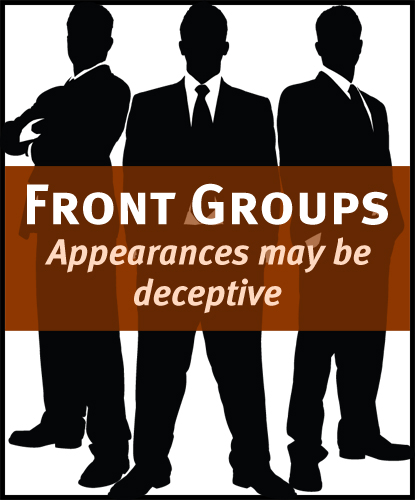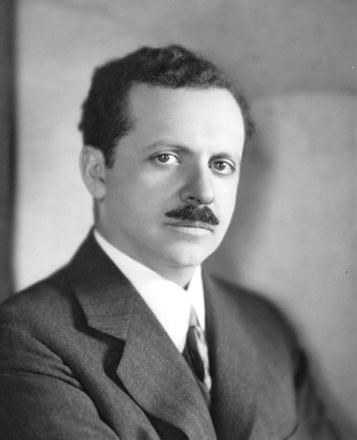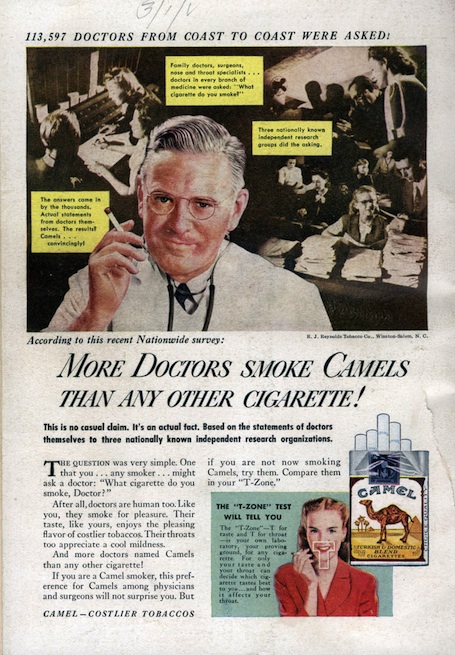Submitted by Judith Siers-Poisson on
"The American public deserves to know when someone is trying to persuade them." — U.S. Federal Communications Commissioner Jonathan Adelstein, Thursday, January 17, 2008
Front Groups Beware of Full Frontal Scrutiny
 Today, the Center for Media and Democracy and our partners at Consumer Reports WebWatch launched an exciting new project: Full Frontal Scrutiny. The site seeks to shine a light on front groups -- organizations that state a particular agenda, while hiding or obscuring their identity, membership or sponsorship, or all three. Google the term "front groups" and the number one return is CMD's extensive articles on its SourceWatch site.
Today, the Center for Media and Democracy and our partners at Consumer Reports WebWatch launched an exciting new project: Full Frontal Scrutiny. The site seeks to shine a light on front groups -- organizations that state a particular agenda, while hiding or obscuring their identity, membership or sponsorship, or all three. Google the term "front groups" and the number one return is CMD's extensive articles on its SourceWatch site.
WebWatch and CMD will create original content for Full Frontal Scrutiny, which will also publish selected content from WebWatch and from the CMD's SourceWatch and PRwatch sites, as well as aggregating news about front groups from other reliable sources.
As CMD Research Director Sheldon Rampton said, "Full Frontal Scrutiny will be like no other site on the Web. Fakers, phonies and front groups beware -- you will be exposed."
Full Frontal Scrutiny adds to the CMD mix the extensive experience that Consumer Reports' WebWatch brings in looking specifically at the Web presence of organizations. "For six years, Consumer Reports WebWatch has evaluated sites against five simple guidelines for credibility and trustworthiness," said Beau Brendler, WebWatch's director. "Who owns the site? What's its purpose and mission? Does it disclose sources of funding or key relationships with third parties? These are important questions for consumers to ask about any Web site, and they're also remarkably effective for ferreting out sites that intend to spin, obfuscate or dress up an unpopular agenda."
Full Frontal Scrutiny will focus on front groups in the health, personal finance, electronics and Internet, automotive, home, environment, travel and other topic areas of particular interest to Consumers Union and within its expertise. Other types of front groups will still be reported on within SourceWatch and on CMD's home site as part of CMD's wider mission.
What People are Saying About Full Frontal Scrutiny
Full Frontal Scrutiny is already gaining some attention. Craig Newmark, founder of Craigslist and a board member of Consumers Union, has been a great supporter of the project. As he said on his blog on Huffington Post,
You're probably already aware of front groups, which pretend to represent grassroots efforts, and are actually run by suspect politicians or shady corporations. They're sometimes called "astroturf," since they're the opposite of honest grassroots efforts. More bluntly, the purpose of a front group is to deceive consumers or voters. ... I've taken a good look at all involved, and they're for real, CU and CMD have outstanding records for integrity and accuracy.
Ari Melber of The Nation said that,
Activists are using a new, open source web campaign to expose companies that are faking open source web campaigns. You read that right. Some companies have seized on web organizing to create fake "astroturf" groups or pose as citizen journalists to advance corporate PR. Today those dogged Wisconsin organizers at the Center for Media and Democracy launched a new wiki-powered activist site to expose such front operations, called Full Frontal Scrutiny.
Ellen Miller, Executive Director of the Sunlight Foundation, CMD's partner in the Congresspedia project, had this to say:
Full Frontal Scrutiny will give consumers, voters and citizens a resource for investigating organizations they run across in the media or elsewhere that have popped up to promote a particular opinion or bill in Congress. We love the banner on the site that includes this quote from Jonathan Adelstein, commissioner at the FCC: "The American public deserves to know when someone is trying to persuade them." The organizers say it's this spirit that is their motivation for exposing "hidden persuaders." This is a new battle being waged in the spirit of transparency.
A Little Background Information on Front Groups
 The earliest documented example of a "front group" was the the work of Edward Bernays, a nephew of Sigmund Freud who is widely considered the "father of public relations." Bernays began working as a press agent for theatres, hotels and other businesses in 1913. Bernays helped jump start sales of bacon, a breakfast rarity until the 1920s, by enlisting a prominent doctor to solicit fellow doctors' opinions on the health benefits of a hearty breakfast and by arranging to have famous figures photographed eating breakfasts of bacon and eggs. To sell bananas on behalf of the United Fruit Company, he launched the "celiac project," republishing and disseminating a 20-year-old medical paper which found that eating bananas cured children with celiac disease, a disorder of the digestive system.
The earliest documented example of a "front group" was the the work of Edward Bernays, a nephew of Sigmund Freud who is widely considered the "father of public relations." Bernays began working as a press agent for theatres, hotels and other businesses in 1913. Bernays helped jump start sales of bacon, a breakfast rarity until the 1920s, by enlisting a prominent doctor to solicit fellow doctors' opinions on the health benefits of a hearty breakfast and by arranging to have famous figures photographed eating breakfasts of bacon and eggs. To sell bananas on behalf of the United Fruit Company, he launched the "celiac project," republishing and disseminating a 20-year-old medical paper which found that eating bananas cured children with celiac disease, a disorder of the digestive system.
The tobacco industry, another early Bernays client, also relied heavily on expert testimonials to tout its products, recruiting opera singers and doctors to claim that cigarettes soothed the throat and aided digestion. Advertisements of this type became so ubiquitous that Bernays spoofed one of his industry rivals by creating a front group called the "Tobacco Society for Voice Culture" which mockingly claimed that its mission was to "establish a home for singers and actors whose voices have cracked under the strain of their cigarette testimonials."
Beginning during the buildup to the Second World War, front groups also were employed increasingly by extremist political parties, as a way of mainstreaming their political views. This practice continues today, but corporations and their public relations firms continue to be far the most common sponsors of front groups for the purpose of shaping public opinion.
A Different Kind of Third Party
 A front group is an example of what is known in the PR trade as the third party technique. The idea behind the term is that when one person (the "first party") wants to persuade someone else (the "second party") to believe or do something that benefits the first party, it helps if the message comes from a seemingly disinterested, independent source. As Daniel Edelman, the founder of Edelman PR Worldwide, has stated, "A third party endorsement can position a new brand so that it's poised for great success or, conversely, can blunt a serious problem before it gets out of hand and proves disastrous for a particular product or for a company overall."
A front group is an example of what is known in the PR trade as the third party technique. The idea behind the term is that when one person (the "first party") wants to persuade someone else (the "second party") to believe or do something that benefits the first party, it helps if the message comes from a seemingly disinterested, independent source. As Daniel Edelman, the founder of Edelman PR Worldwide, has stated, "A third party endorsement can position a new brand so that it's poised for great success or, conversely, can blunt a serious problem before it gets out of hand and proves disastrous for a particular product or for a company overall."
Front groups constitute an attempt to manufacture a third party, creating the appearance of independence while in fact the so-called independent voice is actually beholden to some hidden or rarely-mentioned sponsor. How effective is this strategy? According to a survey commissioned by the Porter/Novelli PR firm, 89 percent of respondents consider "independent experts" a "very or somewhat believable source of information during a corporate crisis." Sometimes the technique is used to hype or exaggerate the benefits of a product.
Other times it is used to create doubt about a product's hazards, or about criticisms that have been made of a company's business practices. You used to see this technique in its most obvious and crude form in the television commercials that featured actors in physicians' lab coats announcing that "nine out of ten doctors prefer" their brand of aspirin. But advertisements are obvious propaganda, and the third party technique in its more subtle forms is designed to prevent audiences from even realizing what they are experiencing. "The best PR ends up looking like news," bragged one public relations executive. "You never know when a PR agency is being effective; you'll just find your views slowly shifting."
Sometimes the identity of the messenger becomes symbolically more important than the content of the message itself. Timber industry consultant Ron Arnold, who founded the "Wise Use" movement as a pseudo-grassroots campaign against environmentalism, explained the rationale behind his use of the third party technique: "The public is completely convinced that when you speak as an industry, you are speaking out of nothing but self-interest. The pro-industry citizen activist group is the answer to these problems. It can be an effective and convincing advocate for your industry. It can utilize powerful archetypes such as the sanctity of the family, the virtue of the close-knit community, the natural wisdom of the rural dweller ... And it can turn the public against your enemies. ... I think you'll find it one of your wisest investments over time."
As these examples illustrate, the creators of front groups often go to considerable effort to disguise or minimize public awareness of the identities of their sponsors. For this reason, it can be difficult to know when an organization is a front group. Hopefully, the articles and resources on Full Frontal Scrutiny can help.

Comments
Mutternich replied on Permalink
Great idea.